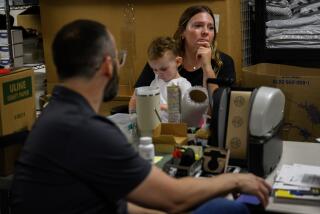Washington seeks to define a standard dosage for pot
- Share via
SEATTLE -- Patients using marijuana for ailments ranging from chronic back pain to cancer are allowed by Washington state law to possess a two-month supply of the drug. But medical marijuana doesn’t come with a standard dose or even a standard method of taking the drug.
The 1998 law has never spelled out how much usable pot nor how many plants make up a 60-day supply.
Now the Legislature has demanded an answer to the question by July, and the state is holding hearings to ask experts and citizens for their opinions on how to determine a two-month supply.
“There is so much you will have to take into account,” says Joanna McKee, founder of Seattle’s Green Cross Patient Co-op. “What about people who eat it? How different is the amount they need from people who smoke it?”
McKee was one of many who spoke at a state health department public meeting this month in Seattle. More than 100 people attended, and about 45 people spoke. Another meeting in Spokane drew similar numbers.
Most people at the meetings were clearly medical marijuana advocates. So are most who have posted comments on a Washington Department of Health website, but a few have written to express dismay at any use of marijuana. “It is a waste of our time and resources to address this non-issue,” reads one such comment.
But the issue is crucial for patients who use medical marijuana.
“What has ended up happening is that in each county, law enforcement effectively decides what constitutes a 60-day supply,” says attorney Alison Holcomb, Marijuana Education Project director for the state ACLU. “And in some counties, that amount has been set at zero.”
Of the 12 states that protect medical marijuana patients from state prosecution, Washington is the only one without clear guidelines on the amount a patient or designated caregiver is allowed to possess.
Those amounts are different in almost every other state. Oregon allows the largest supply -- 24 ounces or six mature plants -- and several states only allow patients to have one ounce of usable marijuana on hand. In California, state law sets a limit of 8 ounces or six mature plants, but cities and counties are free to establish higher guidelines.
Dr. Gregory T. Carter, a professor of rehabilitative medicine at the University of Washington School of Medicine who studies the effects of marijuana in treating patients with ALS, or amyotrophic lateral sclerosis, says that all of these codified limits may be too low.
“There are so many variables here. Even if you just look at smokers, you have to look not only at the quality of the pot, but also at the efficiency of the smoker,” he says. “Some people are better smokers than others.”
Carter and several colleagues studied the dose amounts used on a federal study of medical marijuana, which has been in progress for more than 30 years. Based on this, he says that a 60-day supply works out to nearly 4 1/2 pounds per patient -- far more than the amount allowed by any state.
And, he says, “that’s probably a pretty conservative estimate.”
Tom McBride, executive secretary of the Washington Assn. of Prosecuting Attorneys, welcomes the change in the law. “It doesn’t make sense for a judge or prosecutor to have to determine how much a sick person needs -- that’s a medical decision, and I’ve always felt it should be made by a doctor.”
McBride says he isn’t worried about a high limit shielding recreational pot dealers.
“Under Washington law,” he says, “group growing and distribution isn’t legal, and codifying a 60-day supply won’t change that.”
Many advocates hope the state will ultimately allow patient co-ops to grow and distribute medical pot, as is the case in some parts of California. But no one expects that to happen here any time soon.
Bruce Mirken is director of communications at the Marijuana Policy Project, a national nonprofit group that works for both medical and recreational marijuana policy reform. He worries that Washington’s new definition will be set too low, but at the same time emphasizes that safe access remains the larger issue for all medical marijuana patients.
“It’s going to remain a problem, as long as the federal government remains hostile to medical marijuana,” he says.
That worry was reflected in many of the comments offered at the Seattle meeting.
Caroline Welch, 47, was one of the first to tell her story. Diagnosed with stage-three ovarian cancer earlier this summer, Welch attributes much of her ability to withstand her treatment to medical marijuana.
“There were people producing it for me before I knew I’d even need it,” she says. “It would have taken me till next summer to cultivate the plants, get the knowledge base. There is no way that I could have done it.”
McKee, of the Seattle patient co-op, said she had worked with thousands of medical marijuana patients over the years. “I have never seen anyone with a 60-day supply. I have seen people with a few ounces, a few plants,” she said.
Public comments on the issue will be accepted until the end of the year, and in early 2008, the department of health will publish a proposed rule. The final rule must be in place by July, which is also the deadline for the health department to report back to the Legislature on the issue of safe access to medical marijuana.
More to Read
Sign up for Essential California
The most important California stories and recommendations in your inbox every morning.
You may occasionally receive promotional content from the Los Angeles Times.










